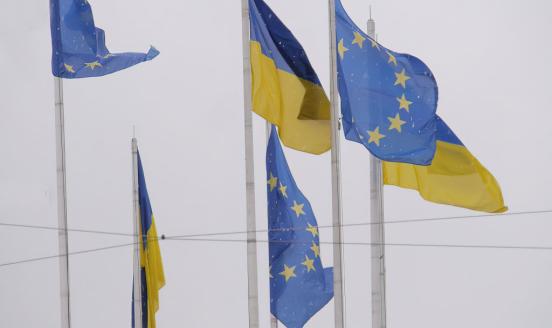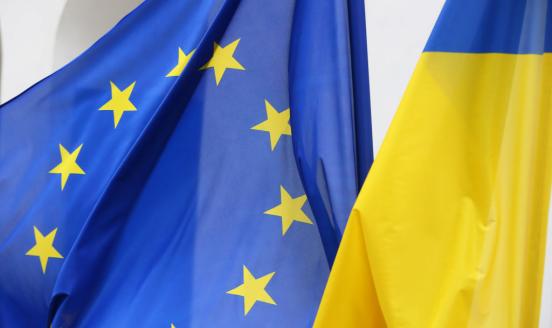EU Association Agreement could help Ukraine to reform
Ukraine’s closer ties with the EU have been controversial. The Association Agreement is now facing a referendum in the Netherlands. But what exactly i
On 6 April the Netherlands will hold a referendum on the new EU-Ukraine Association Agreement. In the meantime, full ratification and implementation is on hold. The EU intended that this agreement would be the blueprint for a new kind of partnership with its Eastern neighbours. It entails substantial political cooperation and includes the creation of a Deep and Comprehensive Free Trade Area (DCFTA). There is no explicit mention of EU membership, but some fear that an Association Agreement will de facto mark the start of EU accession for a large, poor and geopolitically challenging country.
How did we get here?
The EU’s first pact with Ukraine was a Partnership and Cooperation Agreement signed in 1994. In 2007 Ukraine and the EU began negotiating a new form of cooperation, which was given Association Agreement status at the EU-Ukraine Summit in Paris in September 2008. This was also when it was confirmed that the agreement would incorporate a DCFTA, which was made possible by Ukraine’s accession to the World Trade Organisation in February 2008.
Negotiations were completed in December 2011, but it took more than two years before the political and trade sections were signed. These years were marked by the political zigzags of President Yanukovych’s administration and its collapse in February 2014 as result of Euromaidan. There followed the annexation of Crimea, the beginning of the war in Donbass and a deteriorating economic situation in Ukraine[1].
By November 2015 the Association Agreement had been ratified in the European Parliament, Ukraine’s Verkhovna Rada and the parliaments of the 28 EU member states. However, when a referendum was triggered in the Netherlands, this suspended the ratification act of the Dutch Parliament. In March 2016 only those parts of the agreement which cover full EU competences (mainly in trade and financial cooperation) have been provisionally applied[2], while the rest waits for the result of the Dutch referendum.
What does the agreement cover?
The EU-Ukraine Association Agreement is wide-ranging[3], with titles covering:
- General principles
- Political dialogue and reform, including gradual convergence in areas of security, defence and foreign policy
- Justice, freedom and security, including prospects of visa-free travel
- Trade and trade-related matters, essentially the DCFTA
- Economic and sector cooperation
- Financial cooperation, including anti-fraud provisions
- Institutional, general and final provisions
The list of sectors and issues covered by Title 5 is impressive. It includes, among others, macroeconomic policies and state administration, energy and nuclear policy, consumer and environmental protection, corporate governance, employment issues and education, public health and social policies. This cooperation will be based on gradual approximation with the EU legislation and with respective international norms and standards. Ukraine will also participate in European agencies and programmes, and take part in cross-border and regional cooperation
The Association Agreement itself does not involve any meaningful free movement of labour. It delegates this issue to bilateral intergovernmental agreements between Ukraine and individual EU member states.
How much trade integration will occur?
The section on trade and trade-related issues is economically the most important part of the Association Agreement. It applies the innovative concept of a ‘Deep and Comprehensive Free Trade Area’ (DCFTA). This is based on the experience of the European single market, the European Economic Area, and trade agreements between the EU and prospective EU candidates. As well as scrapping tariffs on the trade of goods (usually with some exceptions related to agriculture products), DCFTAs include the reduction or removal of non-tariff barriers.
DCFTAs aim to liberalise investment regimes. They provide domestic treatment of investors from partner countries and mechanisms for international arbitration in case of investor rights disputes. They liberalise trade in services, protect intellectual property rights, harmonise state aid and competition rules, and offer access to the public procurement markets of a partner country. Such a broad agenda for trade and investment liberalisation requires either far-reaching harmonisation or mutual recognition of various trade and investment-related regulations and institutions.
The EU-Ukraine DCFTA includes all the above mentioned components and measures[4]. Harmonisation of Ukraine’s trade and investment regimes with those of the EU will be based on gradual adoption of the relevant EU legislation by the Ukrainian side. This will allow Ukrainian enterprises partial access to the European single market in goods, services and capital.
There are some exceptions to the free movement of goods, which mainly concern trade in agricultural goods. Ukrainian exporters’ access to the EU market will in most cases still be restricted and regulated by EU import tariffs and tariff rate quotas (tariff exemptions for certain quantities of imported agricultural products — these quantities will gradually increase). On the other hand, Ukraine received the right to phase out customs duties for cars imported from the EU and export tariffs for some raw materials (such as sunflower seeds, metal scrap, livestock and leather). It also obtained a transition period of up to ten years to rebrand domestic products such as cognac or champagne so that they fully respect EU protected geographical indications.
Importantly, the DCFTA between the EU and Ukraine also includes a chapter on trade aspects of energy cooperation. One aim of this is to guarantee safe and uninterrupted transit of natural gas through Ukraine to Europe.
What benefits could a DCFTA offer?
Before the AA was signed various trade analyses, in most cases based on Computable General Equilibrium modelling, estimated the potential long-term cumulative welfare gains for Ukraine to be in the range of 5 to 10% and less than 1% for the EU[5].
Both potential gains and adjustment costs will be greater for Ukraine because it is the smaller partner with higher initial trade barriers and higher exposure to bilateral trade. It is worth remembering that most of these estimates used pre-WTO-accession, pre-DCFTA-negotiation, and pre-2008-crisis data, without knowledge of the details of the DCFTA.
Since 2014, Ukraine’s geopolitical situation has further changed the basic assumptions of those estimations. Ukraine has lost the regions which had the most intensive trade relations with Russia: Crimea and Donbass. The conflict itself, the resulting recession in both countries and the sharp depreciation of their currencies further contributed to disruption in bilateral trade. Finally, in January 2016, Russia suspended a free trade agreement between with Ukraine. All these circumstances must lead to a decreasing role for Russia in total Ukrainian trade and an increasing share for the EU.
Indeed, this has been confirmed by the available trade statistics.[6] Between 2012 and 2014 (data for 2015 are not available yet) the share of the EU-28 in total Ukraine’s exports went up from 24.9% to 31.5% — and in Ukraine’s total imports from 31.0% to 38.7%. In the same period, the share of CIS countries (including Russia, once Ukraine’s biggest trade partner) decreased from 36.8% to 27.6% of total exports and from 40.7% to 31.7% of total imports. The total value of Ukrainian exports decreased by 21.7% and imports by 35.8%.
Given continuation of the conflict with Russia, including Russia’s trade sanctions against Ukraine, a further decrease in Ukraine’s trade volume and increase in the share of the EU-28 is to be expected. This makes fast implementation of the EU-Ukraine DCFTA even more important for Ukraine than it was a few years ago.
What non-trade improvements could the agreement bring?
The advantages of the AA are not limited to bilateral trade creation and associated welfare gains. The agreement could also bring structural and institutional benefits.
Harmonisation with EU product standards should offer Ukrainian enterprises better access to third-country markets as well as the EU. Eventually, this should help Ukrainian enterprises become part of global value chains. Harmonisation will also increase the quality and safety of domestically produced and traded goods and services. Stronger competition in the domestic market will lead to better consumer choice.
Regulatory and institutional harmonisation may help to improve the business and investment climate in Ukraine. The additional inflow of foreign direct investment will contribute to the modernisation of Ukraine’s economy, enterprise restructuring, job creation, and possibly a greater diversification of its sectoral and product structure. Indirectly, it should help reduce its high energy intensity.
Finally, the institutional provisions of the AA may help to improve the rule of law, domestic policy transparency and the fight against corruption. They will also offer an external anchor and benchmark for domestic policies and regulations.
Nevertheless, these benefits will only materialise with political determination and if Ukrainian authorities have the administrative capacity to implement the provisions quickly and accurately. This may be a serious challenge for the country, which has so far had a mixed record in reforming its economy and government.
For the EU, apart from having an attractive economic partner, the main benefit of the Association Agreement is geopolitical. A politically stable and economically prosperous Ukraine is in the best interest of all people in Europe. This was also the reason for offering similar agreements to other Eastern Partnership countries. So far two of them – Georgia and Moldova – have signed an Association Agreement and begun implementation.
What is not in the EU-Ukraine Association Agreement?
The EU signed three association agreements with Eastern Partnership countries (Georgia, Moldova and Ukraine) in 2014, which demonstrate an innovative approach to neighbourhood trade partnerships. They are more ambitious than the agreements concluded in the late 1990s and early 2000s with southern Mediterranean countries, which are also part of the European neighbourhood policy. They offer a more comprehensive cooperation framework, especially in trade, investment and institutional matters.
In this respect the new AAs copy the template of the trade and association agreements (TAAs) signed in the 1990s with the prospective EU candidates from central and eastern Europe, who became EU members in 2004 and 2007. They also resemble the stabilisation and association agreements (SAAs) signed with western Balkan countries in the 2000s and 2010s, many of whom have since become official candidates for EU membership.
There is, however, one important difference between TAAs/SAAs and the new association agreements with Eastern Partnership countries – the latter do not refer to the EU membership prospects of the partners. The Preamble of the EU-Ukraine Association Agreement contains only general acknowledgment of ‘…the European aspirations of Ukraine and…its European choice, including its commitment to building a deep and sustainable democracy and a market economy’.
Of course, the Association Agreement does not invalidate Article 49 of the Treaty on European Union, which gives each European state the right to apply to become an EU member, so long as it respects basic democratic and human rights and is committed to promoting them. Nevertheless, the agreement itself offers neither a political nor a legal promise of future EU membership. This must be taken into consideration by those who argue (for whatever reason) that the agreements signed by the EU with Ukraine, Moldova and Georgia means opening an EU accession process for those countries.
I would like to thank Guntram Wolff and Georg Zachmann for their comments to the earlier version of this article.
[1] See https://bruegel.org/wp-content/uploads/imported/publications/pc_2014_08_Ukraine.pdf for an overview.
[2] http://eur-lex.europa.eu/legal-content/EN/TXT/PDF/?uri=OJ:L:2014:278:FULL&from=EN
[3] For the full text see http://eeas.europa.eu/ukraine/docs/association_agreement_ukraine_2014_en.pdf
[4] See http://trade.ec.europa.eu/doclib/html/150981.htm
[5] See http://www.case-research.eu/sites/default/files/publications/CNSA_2012_437.pdf for an overview
[6] https://ukrstat.org/en/operativ/operativ2005/zd/zd_rik/zd_e/gs_rik_e.html



